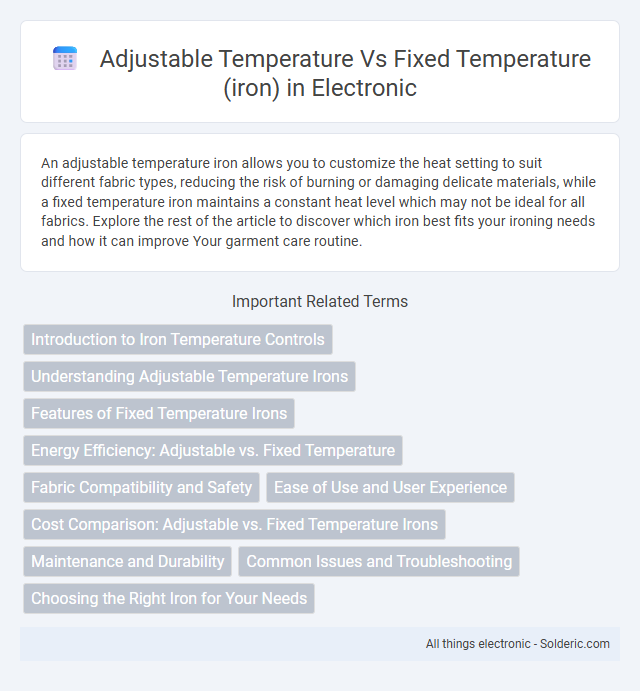An adjustable temperature iron allows you to customize the heat setting to suit different fabric types, reducing the risk of burning or damaging delicate materials, while a fixed temperature iron maintains a constant heat level which may not be ideal for all fabrics. Explore the rest of the article to discover which iron best fits your ironing needs and how it can improve Your garment care routine.
Comparison Table
| Feature | Adjustable Temperature Iron | Fixed Temperature Iron |
|---|---|---|
| Temperature Control | Variable settings from low to high | Single, constant temperature setting |
| Fabric Compatibility | Suitable for all fabric types | Limited to fabrics tolerating fixed temperature |
| Energy Efficiency | Consumes energy based on selected temperature | Consistent energy use regardless of fabric |
| Ease of Use | Requires temperature setting adjustment | Simple, plug and play operation |
| Cost | Generally higher price due to features | Often more affordable |
| Damage Risk | Lower risk with proper setting | Higher risk on delicate fabrics |
Introduction to Iron Temperature Controls
Adjustable temperature irons offer precise heat settings that adapt to various fabrics, preventing damage and enhancing fabric care. Fixed temperature irons operate at a single heat level, making them simpler but less versatile for delicate materials. Your choice in iron temperature controls can significantly impact the longevity and appearance of your clothing.
Understanding Adjustable Temperature Irons
Adjustable temperature irons provide precise control over heat settings, allowing you to select the optimal temperature for different fabrics, which helps prevent scorching or damage. Fixed temperature irons operate at a single heat level, which may be less versatile for delicate or varied materials. Understanding adjustable temperature irons enables you to achieve better ironing results and extend the longevity of your garments.
Features of Fixed Temperature Irons
Fixed temperature irons operate at a single, consistent heat setting, providing simplicity and ease of use for users who prefer straightforward tools without the need for adjustments. These irons often feature durable heating elements designed to maintain steady temperatures, minimizing the risk of overheating or temperature fluctuations during ironing sessions. Ideal for routine fabric types like cotton or linen, fixed temperature irons offer reliable performance and energy efficiency without the complexity of variable temperature controls.
Energy Efficiency: Adjustable vs. Fixed Temperature
Adjustable temperature irons offer superior energy efficiency by allowing you to set the heat precisely according to the fabric type, reducing unnecessary power consumption. Fixed temperature irons, however, maintain a constant heat level that often wastes energy when higher temperatures are not needed. Optimizing your iron's temperature settings ensures less energy usage and prolongs the appliance's lifespan.
Fabric Compatibility and Safety
Adjustable temperature irons offer superior fabric compatibility by allowing precise heat settings suited for delicate materials like silk or polyester, reducing the risk of burns or damage. Fixed temperature irons lack this flexibility, increasing the chance of fabric scorching or insufficient ironing on diverse textiles. Your best choice is an adjustable temperature iron to ensure both safety and optimal fabric care.
Ease of Use and User Experience
Adjustable temperature irons offer enhanced ease of use by allowing you to tailor the heat setting to different fabric types, preventing damage and improving ironing efficiency. Fixed temperature irons lack this customization, often requiring caution to avoid burning delicate materials, which can frustrate users. Your ironing experience becomes more intuitive and safer with adjustable temperature control, ensuring optimal results across various clothing items.
Cost Comparison: Adjustable vs. Fixed Temperature Irons
Adjustable temperature irons typically cost more upfront due to advanced heating elements and digital controls, offering precise temperature settings for versatile fabric care. Fixed temperature irons are generally cheaper but risk damaging delicate fabrics without temperature control, potentially leading to replacement costs. Investing in an adjustable iron can save you money over time by extending your iron's lifespan and protecting your clothes from heat damage.
Maintenance and Durability
Adjustable temperature irons offer better maintenance and durability by allowing you to select the optimal heat level for different fabric types, reducing the risk of damage and extending the iron's lifespan. Fixed temperature irons often cause overheating and wear on sensitive materials, leading to frequent repairs or replacements. Your careful temperature adjustments can significantly enhance the durability and long-term performance of your iron.
Common Issues and Troubleshooting
Adjustable temperature irons often face issues like inaccurate temperature readings or sensor malfunctions, which can lead to inconsistent heat application, while fixed temperature irons typically suffer from overheating or insufficient heat for specific fabrics. Troubleshooting an adjustable temperature iron involves recalibrating the temperature control or replacing faulty sensors to restore precision. For fixed temperature models, ensuring proper ventilation and cleaning the heating element can help maintain optimal performance and extend your iron's lifespan.
Choosing the Right Iron for Your Needs
Choosing the right iron depends on your fabric care needs and convenience preferences. Adjustable temperature irons offer versatility by allowing precise heat settings for different materials, reducing the risk of damage and enhancing garment longevity. Fixed temperature irons are simpler and often more affordable, suitable if you primarily iron similar fabrics that require uniform heat.
adjustable temperature vs fixed temperature (iron) Infographic

 solderic.com
solderic.com